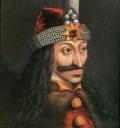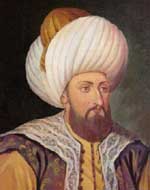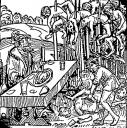Prince Vlad III of Wallachia, also known as Vlad Tepes or Vlad Dracula.
 As I previously mentioned, I’m going to write some blogs about famous historical or legendary characters of East Europe. I’m going to start, of course, with the most legendary and famous of all:
As I previously mentioned, I’m going to write some blogs about famous historical or legendary characters of East Europe. I’m going to start, of course, with the most legendary and famous of all:
Prince Vlad III of Wallachia, also known as Vlad Tepes or Vlad Dracula, a bloody figure and basic inspirer of the worldwide known vampire Count Dracula, with novels, books and movies we all know.
He is described as a short man, well build, with jet black long hair; he used to shave his face, except for the moustaches. His big green eyes, shaded by dark and tight eyebrows, along with a hooked nose, gave his face a cold and cruel look.
Historical facts:
Today in the Podisul Plateau, near Budapest, you can visit the medieval village of Sighisoara. Among the wooden and stone ancient houses, there is still the existence of the native home of Dracula. A sign tells the visitors that Vlad Tepes was born there in 1431 and lived there since 1435. After this early years, he grow up in the Tirgoviste Castle, the originary capitol of Wallachia. He had 3 brothers: Mircea, older brother, that he admired, who inspired his desire to become a warrior and a conqueror; Radu, also known as “the beautiful”, and the illegitimate one also called Vlad, who lived his entire life in a convent with his mother.
Vlad III had to fight many times for the Wallachia throne against his uncle first, and then against his cousin Daniel, always plotting against him. Two opposite factions fought for the 2 cousins: the Danesti (Daniel’s supporters) and Draculesti.
 His father, Vlad II, stipulated a cowardish but advantageous agreement with Ottoman Sultan Murad II: in exchange for the Sultan’s military support he let him ride and predate all the countries around Wallachia, invading Est Europe also thanks to the strategical suggestion of Vlad II, who obtained Wallachia and part of Transilvania Principality.
His father, Vlad II, stipulated a cowardish but advantageous agreement with Ottoman Sultan Murad II: in exchange for the Sultan’s military support he let him ride and predate all the countries around Wallachia, invading Est Europe also thanks to the strategical suggestion of Vlad II, who obtained Wallachia and part of Transilvania Principality.
But the Turks had no easy way into the Eastern Europe, even with Vlad’s help, so he betrayed them many times for his convenience, causing the Sultan’s wrath. Trying to calm Murad, Vlad II came to visit him with his 2 sons Vlad and Radu (notice that he didn’t took his favourite, Mircea…) and he came back in Wallachia alone, since the Sultan kept the boys as a sign fo Vlad’s good will, and as excellent hostages. Radu, also known as “the Beautiful”, became the sultan’s lover and joined the male harem; Vlad, more interested in war tactics and fighting, was trained by the Janissaries ( the Ottoman Sultan’s household troops and bodyguard); there, he witnessed cruelty, tortures and violence and learned the impaling torture, that seemed to leave a deep mark in his mind. You need to remember, by the way, that Vlad and Radu lived in the Sultan’s curt as prisoners in a golden cage. Romanian prisoners in the heart of the Ottoman Empire.
Meanwhile in Wallachia Vlad II and his son Mircea turned against the turks once more, until they were tortured and assassined in 1447. Although Vlad II’s umpteenth betrayal, Vlad III and Radu kept living their life in the Sultan’s Court, instead of suffering the awful destiny the traitor’s sons could be expected to meet.
In 1448, one year after his father’s death, Vlad leaves the Sultan to reclaim Wallachia’s Principality back, while his brother  Radu stays with the Sultan, due to his ambiguous relationship with him. Vlad III had to fight many times for Wallachia, he is actually considered a patriotic hero for his relentless fight to banish Octomans once he had the Principality back. He had to fight his uncle first and his cousin Daniel then, to reconquer his throne for 3 times: 1448, then from 1456 to 1462 and in 1476, the year he died.
Radu stays with the Sultan, due to his ambiguous relationship with him. Vlad III had to fight many times for Wallachia, he is actually considered a patriotic hero for his relentless fight to banish Octomans once he had the Principality back. He had to fight his uncle first and his cousin Daniel then, to reconquer his throne for 3 times: 1448, then from 1456 to 1462 and in 1476, the year he died.
The stories about his atrocities are countless… from thousend of impaled enemies left out of the conquered cities, howling and weeping for days, to the brutal death he gave to his 2 wives by his hands.
People used to call Prince Vlad III by many names. Here are the most famous with some brief notes:
Vlad Tepes (pronunce: Tzah-Pash):
Tepes means “impaler” in Romanian: people called him so because of his favourite torture he used to inflict to enemies and traitors. The impaling torture hit people’s imagination and shocked them, because it was something new to his people, since Vlad III learned it from Octomans in the time he spent by the Sultan Murad. Just imagine how strange, cruel and exotic that torture could seem to Romanians, that also explains the terror and legends about his endless cruelties and bloodthirst. About blood drinking: it is proved that was only a rumor, since Prince Vlad never used to drink enemies blood… but this rumor, along with his scary personality and story, inspired the creation of one of the most worldwide famous fictionary characters: Count Dracula the Vampire, from the Bram Stoker’s novel.
 Vlad Dracula:
Vlad Dracula:
Vlad III, and his father too, was a member of the Order of the Dragon (Societas Draconis in Latin), along with the rulers of Poland and Serbia. The purpose of the Order was to protect Eastern Europe and the Holy Roman Empire from Islamic expansion as embodied in the campaigns of the Ottoman Empire, especially fighting the herectic Hussites.
So, Vlad II was also called “Dracul” (that means “Dragon”)… but also “Devil” in Romanian. The last “a” of Dracula means “son of” so, Dracula literally means “Son of the Dragon” but maybe also “Son of the Devil”.
Kaziglu Bey:
Means “Impaler Prince”: Octomans gave him this name nearly 100 years after Vlad III’s death, in 1550.
I hope you liked my research about this incredible character, because I’ll write more about the Order of the Dragon, on Count Dracula, the novels and movies and much more! For further details about Vlad II, check his Wikipedia page: http://en.wikipedia.org/wiki/Vlad_III_the_Impaler
Serena
Discussion Area - Leave a Comment
You must be logged in to post a comment.